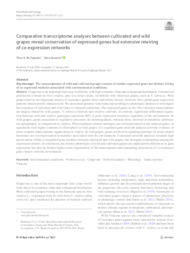Comparative transcriptome analyses between cultivated and wild grapes reveal conservation of expressed genes but extensive rewiring of co-expression networks.
Comparative transcriptome analyses between cultivated and wild grapes reveal conservation of expressed genes but extensive rewiring of co-expression networks.
Author(s): FAJARDO, T. V. M.; QUECINI, V.
Summary: Key message The transcriptomes of wild and cultivated grapes consists of similar expressed genes but distinct wiring of co-expressed modules associated with environmental conditions. Abstract Grapevine is an important fruit crop worldwide, with high economic value and widespread distribution. Commercial production is based on Vitis vinifera, and, to a lesser extent, on hybrids with American grapes, such as V. labrusca. Wild grape relatives are important sources of resistance against biotic and abiotic factors; however, their global gene expression patterns remain poorly characterized. We associated genome-wide transcript profling to phenotypic analyses to investigate the responses of cultivated and wild vines to vineyard conditions. The expressed genes in the Vitis reference transcriptome are largely shared by wild grapes, V. labrusca hybrids and vinifera cultivars. In contrast, signifcant diferential regulation between wild and vinifera genotypes represents 80% of gene expression variation, regardless of the environment. In wild grapes, genes associated to regulatory processes are downregulated, whereas those involved in metabolic pathways are upregulated, in comparison to vinifera. Photosynthesis-related ontologies are overrepresented in the induced genes, in agreement with higher contents of chlorophyll in wild grapes. Co-regulated gene network analyses provide evidence of more complex transcriptome organization in vinifera. In wild grapes, genes involved in signaling pathways of stress-related hormones are overrepresented in modules associated with the environment. Consensus network analyses revealed high preservation within co-regulated gene modules between cultivated and wild grapes, but divergent relationships among the expression clusters. In conclusion, the distinct phenotypes of wild and cultivated grapes are underlain by diferences in gene expression, but also by distinct higher-order organization of the transcriptome and contrasting association of co-expressed gene clusters with the environment.
Publication year: 2021
Types of publication: Journal article
Unit: Embrapa Grape & Wine
Observation
Some of Embrapa's publications are published as ePub files. To read them, use or download one of the following free software options to your computer or mobile device. Android: Google Play Books; IOS: iBooks; Windows and Linux: Calibre.
Access other publications
Access the Agricultural Research Database (BDPA) to consult Embrapa's full library collection and records.
Visit Embrapa Bookstore to purchase books and other publications sold by Embrapa.

